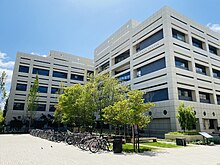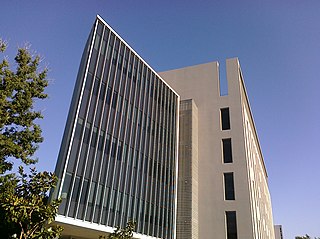
The Beckman Research Institute of City of Hope (BRI) is a not-for-profit medical research facility located at and partnering with the City of Hope National Medical Center in Duarte, California, United States. It is dedicated to studying normal and abnormal biological processes which may be related to cancer, diabetes, HIV/AIDS and other life-threatening diseases. Both basic and clinical research are carried out in cooperation with the City of Hope National Medical Center. The institute itself is organized into more than 20 departments and divisions. As of 2021, the director is Steven T. Rosen. The Beckman Research Institute also hosts the Irell & Manella Graduate School of Biological Sciences whose founding dean was Arthur Riggs.
Stanford University School of Medicine is the medical school of Stanford University and is located in Stanford, California. It traces its roots to the Medical Department of the University of the Pacific, founded in San Francisco in 1858. This medical institution, then called Cooper Medical College, was acquired by Stanford in 1908. The medical school moved to the Stanford campus near Palo Alto, California, in 1959.

Paul Berg is an American biochemist and professor emeritus at Stanford University. He was the recipient of the Nobel Prize in Chemistry in 1980, along with Walter Gilbert and Frederick Sanger. The award recognized their contributions to basic research involving nucleic acids. Berg received his undergraduate education at Penn State University, where he majored in biochemistry. He received his Ph.D. in biochemistry from Case Western Reserve University in 1952. Berg worked as a professor at Washington University School of Medicine and Stanford University School of Medicine, in addition to serving as the director of the Beckman Center for Molecular and Genetic Medicine. In addition to the Nobel Prize, Berg was presented with the National Medal of Science in 1983 and the National Library of Medicine Medal in 1986. Berg is a member of the Board of Sponsors for the Bulletin of the Atomic Scientists.

Scripps Research, previously known as The Scripps Research Institute (TSRI), is a nonprofit American medical research facility that focuses on research and education in the biomedical sciences. Headquartered in San Diego, California, with a sister facility in Jupiter, Florida, the institute has over 200 laboratories employing 2,400 scientists, technicians, graduate students, and administrative and other staff, making it the largest private, non-profit biomedical research organization in the United States and among the largest in the world.

The Beckman Institute for Advanced Science and Technology is a unit of the University of Illinois Urbana-Champaign dedicated to interdisciplinary research. A gift from scientist, businessman, and philanthropist Arnold O. Beckman (1900–2004) and his wife Mabel (1900–1989) led to the building of the Institute which opened in 1989. It is one of five institutions which receive support from the Arnold and Mabel Beckman Foundation on an ongoing basis. Current research at Beckman involves the areas of molecular engineering, intelligent systems, and imaging science. Researchers in these areas work across traditional academic boundaries in scientific projects that can lead to the development of real-world applications in medicine, industry, electronics, and human health across the lifespan.
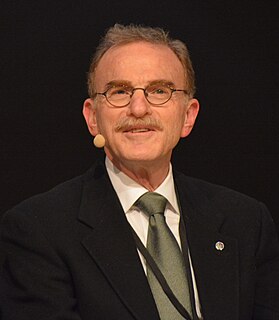
Randy Wayne Schekman is an American cell biologist at the University of California, Berkeley, former editor-in-chief of Proceedings of the National Academy of Sciences and former editor of Annual Review of Cell and Developmental Biology. In 2011, he was announced as the editor of eLife, a new high-profile open-access journal published by the Howard Hughes Medical Institute, the Max Planck Society and the Wellcome Trust launching in 2012. He was elected to the National Academy of Sciences in 1992. Schekman shared the 2013 Nobel Prize for Physiology or Medicine with James Rothman and Thomas C. Südhof for their ground-breaking work on cell membrane vesicle trafficking.
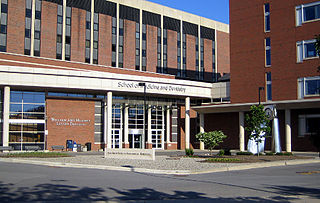
The University of Rochester Medical Center (URMC), now known as UR Medicine, is located in Rochester, New York, is one of the main campuses of the University of Rochester and comprises the university's primary medical education, research and patient care facilities.
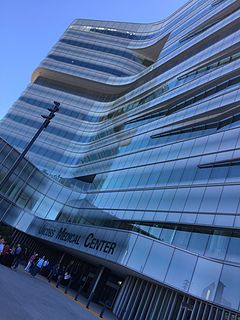
UC San Diego Health is the academic health system of the University of California, San Diego in San Diego, California. It is the only academic health system serving San Diego and has one of only two adult Level I trauma centers in the region. In operation since 1966, it comprises the UC San Diego Medical Center in Hillcrest as well as the; Jacobs Medical Center; Moores Cancer Center; Shiley Eye Institute; Sulpizio Cardiovascular Center, and Koman Family Outpatient Pavilion, all in La Jolla. It also includes several outpatient sites located throughout San Diego County. The health system works closely with the university's School of Medicine and Skaggs School of Pharmacy to provide training to medical and pharmacy students and advanced clinical care to patients.
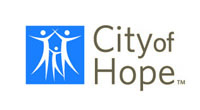
City of Hope is a private, not-for-profit clinical research center, hospital and graduate medical school located in Duarte, California, United States. The center's main campus resides on 110 acre of land adjacent to the boundaries of Duarte and Irwindale, with a network of clinical practice locations throughout Southern California, satellite offices in Monrovia and Irwindale, and regional fundraising offices throughout the United States.
Lu Chen is a Chinese-born American neuroscientist, who is an Professor of Neurosurgery, and of Psychiatry and Behavioral Sciences at Stanford University, and is a member of the Stanford Neurosciences Institute. She was previously an Associate Professor of Neurobiology and a member of the Helen Wills Neuroscience Institute at the University of California, Berkeley.
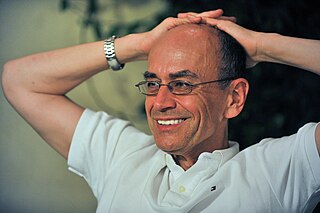
Thomas Christian Südhof, ForMemRS, is a German-American biochemist known for his study of synaptic transmission. Currently, he is a professor in the School of Medicine in the Department of Molecular and Cellular Physiology, and by courtesy in Neurology, and in Psychiatry and Behavioral Sciences at Stanford University.
Beckman Institute may refer to any of five major research centers founded by the Arnold and Mabel Beckman Foundation in the 1980s:

Lucy Shapiro is an American developmental biologist. She is a professor of Developmental Biology at the Stanford University School of Medicine. She is the Ludwig Professor of Cancer Research and the director of the Beckman Center for Molecular and Genetic Medicine. She founded a new field in developmental biology, using microorganisms to examine fundamental questions in developmental biology. Her work has furthered understanding of the basis of stem cell function and the generation of biological diversity. Her ideas have revolutionized understanding of bacterial genetic networks and helped researchers to develop novel drugs to fight antibiotic resistance and emerging infectious diseases. In 2013, Shapiro was presented with the 2011 National Medal of Science. for "her pioneering discovery that the bacterial cell is controlled by an integrated genetic circuit functioning in time and space that serves as a systems engineering paradigm underlying cell differentiation and ultimately the generation of diversity in all organisms."
A Beckman Fellow receives funding, usually via an intermediary institution, from the Arnold and Mabel Beckman Foundation, founded by Arnold Orville Beckman and his wife Mabel. The Foundation supports programs at several institutions to encourage research, particularly the work of young researchers who might not be eligible for other sources of funding. People from a variety of different programs at different institutions may therefore be referred to as Beckman Fellows. Though most often designating postdoctoral awards in science, the exact significance of the term will vary depending on the institution involved and the type(s) of Beckman Fellowship awarded at that institution.
Janet E. Mertz is an American biochemist, molecular biologist, and cancer researcher. She is currently the Elizabeth McCoy Professor of Oncology in the McArdle Laboratory for Cancer Research at the University of Wisconsin – Madison. Mertz is best known for disputing Lawrence Summers' 2005 suggestion that women lack the intrinsic aptitude to excel in mathematics at the highest level and for discovering an easy method for joining DNAs from different species. This latter finding initiated the era of genetic engineering whose ramifications form the basis of modern genetics and the biotechnology industry.
The Beckman Laser Institute is an interdisciplinary research center for the development of optical technologies and their use in biology and medicine. Located on the campus of the University of California, Irvine in Irvine, California, an independent nonprofit corporation was created in 1982, under the leadership of Michael W. Berns, and the actual facility opened on June 4, 1986. It is one of a number of institutions focused on translational research, connecting research and medical applications. Researchers at the institute have developed laser techniques for the manipulation of structures within a living cell, and applied them medically in treatment of skin conditions, stroke, and cancer, among others.
Helen Haskell Hobbs, M.D., is a professor at the University of Texas Southwestern Medical Center, and a Howard Hughes Medical Institute Investigator, who won a 2016 Breakthrough Prize in Life Sciences and the 2018 Harrington Prize for Innovation in Medicine. She and Jonathan C. Cohen found that people with hypomorphic PCSK9 mutations had lower LDL-cholesterol levels and were almost immune to heart disease. This finding led to the development of a new class of cholesterol-lowering drugs that mimic the effects of the PCSK9 mutations. She and Jonathan Cohen also identified the first genetic risk factor for fatty liver disease, a burgeoning health problem that can lead to cirrhosis and liver cancer. Their laboratory has shown that mutation in PNPLA3 causes accumulation of PNPLA3 on lipid droplets, which compromises the mobilization of triglycerides from liver cells. She sits on the Board of Directors at Pfizer.
Nikola Panayot Pavletich is the chair of structural biology at Memorial Sloan Kettering Cancer Center.
Sue Biggins is an American cell biologist who studies kinetochores and the transfer of chromosomes during cell division. Her team isolated kinetochores from cells, enabling them to be studied separately under laboratory conditions. They also discovered that tension helps kinetochores to attach to microtubules and move from the mother cell to the daughter cells when cells divide. The methodology and concepts she developed for yeast kinetochores are being adopted in laboratories around the world. Biggins was elected to the American Academy of Arts & Sciences (AAAS) in 2018.
